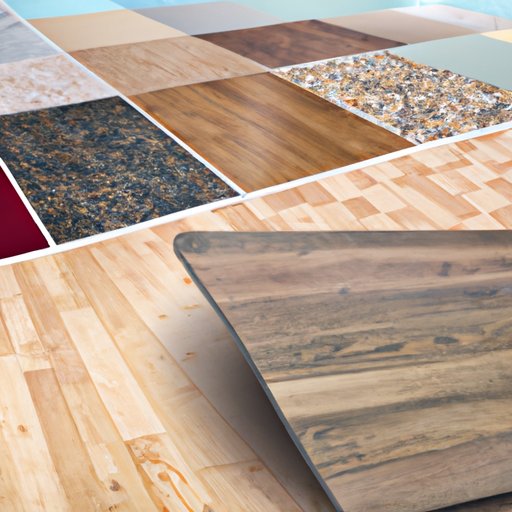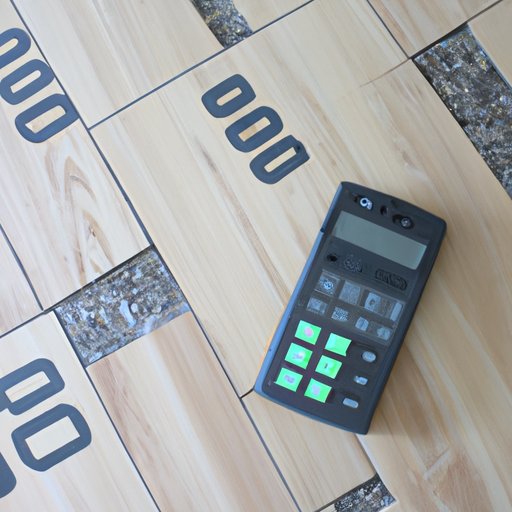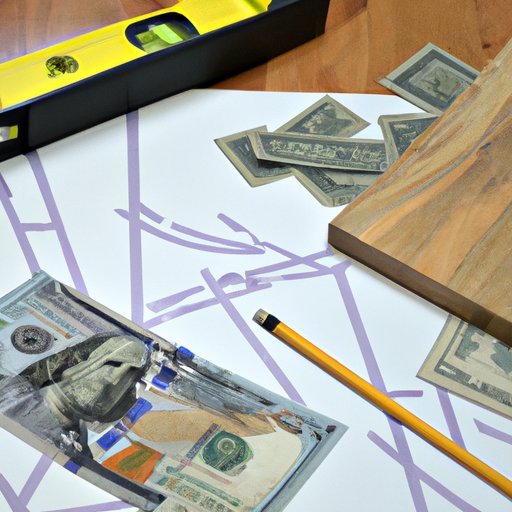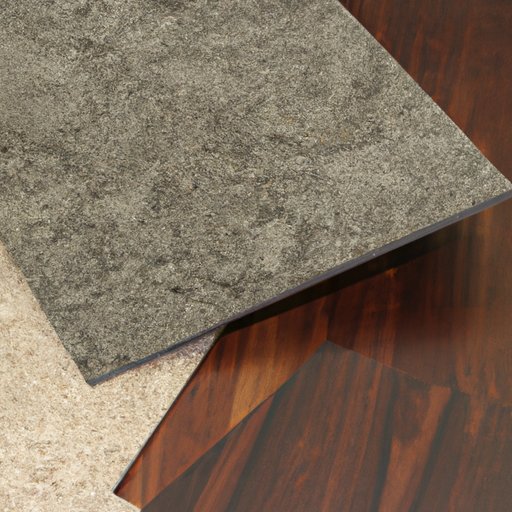Introduction
Whether you’re replacing existing flooring or adding new floors to your home, one of the first questions that comes up is “how much does new flooring cost?” The answer to this question varies widely depending on the type of flooring material you choose, the size of the space, and the labor involved in installation. In this article, we will explore the costs of different types of flooring materials, provide a guide to help you calculate the cost of installing new flooring, and offer tips on how to budget for your project.

Breaking Down the Costs of Different Types of Flooring
When it comes to choosing flooring for your home, there are a variety of materials to choose from, each with its own set of pros and cons. Common flooring materials include carpet, hardwood, laminate, vinyl, tile, and cork. The cost of each of these materials will vary depending on the type and quality of the material, as well as the size of the room or area being covered. Let’s take a look at some of the costs associated with each type of flooring.
Carpet
Carpet is one of the most popular flooring materials for residential homes. According to HomeAdvisor, the average cost of installing carpet is between $1,200 and $4,500. Prices vary based on the type of carpet you choose, as well as the size of the room or area being covered. For example, a 12×12-foot room typically costs around $1,000 to carpet, while a 20×20-foot room may cost up to $3,000.
Hardwood
Hardwood flooring is another popular choice for homeowners, offering a timeless and elegant look. According to HomeAdvisor, the average cost of installing hardwood flooring is between $4,400 and $5,400. Prices vary based on the type of wood you choose, as well as the size of the room or area being covered. For example, a 12×12-foot room typically costs around $2,000 to install hardwood flooring, while a 20×20-foot room may cost up to $6,000.
Laminate
Laminate flooring is a great option for those looking for the look of hardwood without the high price tag. According to HomeAdvisor, the average cost of installing laminate flooring is between $1,700 and $4,000. Prices vary based on the type of laminate you choose, as well as the size of the room or area being covered. For example, a 12×12-foot room typically costs around $800 to install laminate flooring, while a 20×20-foot room may cost up to $3,000.
Vinyl
Vinyl flooring is a durable and affordable option for those looking for a low-maintenance flooring solution. According to HomeAdvisor, the average cost of installing vinyl flooring is between $1,100 and $2,800. Prices vary based on the type of vinyl you choose, as well as the size of the room or area being covered. For example, a 12×12-foot room typically costs around $600 to install vinyl flooring, while a 20×20-foot room may cost up to $2,000.
Tile
Tile flooring is a great choice for those looking for a long-lasting and easy-to-clean flooring option. According to HomeAdvisor, the average cost of installing tile flooring is between $3,000 and $7,000. Prices vary based on the type of tile you choose, as well as the size of the room or area being covered. For example, a 12×12-foot room typically costs around $1,500 to install tile flooring, while a 20×20-foot room may cost up to $5,000.
Cork
Cork flooring is a great choice for those looking for a natural and eco-friendly flooring option. According to HomeAdvisor, the average cost of installing cork flooring is between $3,500 and $6,000. Prices vary based on the type of cork you choose, as well as the size of the room or area being covered. For example, a 12×12-foot room typically costs around $2,000 to install cork flooring, while a 20×20-foot room may cost up to $4,000.

A Guide to Calculating the Cost of Installing New Flooring
When it comes to calculating the cost of installing new flooring, there are several factors to consider. The cost of the project will depend on the labor involved, the materials used, and any additional costs. Here’s a breakdown of what you can expect when calculating the cost of installing new flooring.
Labor Costs
Labor costs are usually the largest component of the overall cost of installing new flooring. Labor costs can range from $2 to $8 per square foot, depending on the complexity of the job and the experience level of the installer. It’s important to do your research and find an experienced and reputable installer to ensure that your flooring is installed correctly.
Material Costs
The cost of the materials used for your flooring project will vary depending on the type of flooring you choose. Generally speaking, carpet, laminate, and vinyl are the most affordable options, while hardwood, tile, and cork tend to be more expensive. Be sure to shop around and compare prices to get the best deal possible.
Additional Costs
In addition to labor and material costs, there are a few other costs you should be aware of. If you’re having your floors professionally installed, you may need to pay for delivery and removal of the old flooring. You may also need to purchase additional materials such as adhesive, underlayment, and trim. Be sure to factor these costs into your budget when calculating the cost of your project.
Exploring the Costs Behind Common Flooring Materials
Now that we’ve discussed the general costs associated with installing new flooring, let’s take a closer look at the costs associated with some of the most popular flooring materials. As mentioned above, the cost of each material will vary depending on the type and quality of the material, as well as the size of the room or area being covered.
Carpet
Carpet is one of the most popular flooring materials for residential homes. The cost of carpet varies widely, depending on the type of carpet you choose. Generally speaking, synthetic carpets are the least expensive, while wool carpets are the most expensive. According to HomeAdvisor, the average cost of installing carpet ranges from $1,200 to $4,500.
Hardwood
Hardwood flooring is another popular choice for homeowners, offering a timeless and elegant look. The cost of hardwood flooring also varies widely, depending on the type of wood you choose. Generally speaking, engineered hardwood is the least expensive, while solid hardwood is the most expensive. According to HomeAdvisor, the average cost of installing hardwood flooring ranges from $4,400 to $5,400.
Laminate
Laminate flooring is a great option for those looking for the look of hardwood without the high price tag. The cost of laminate flooring also varies widely, depending on the type of laminate you choose. Generally speaking, laminate flooring with a thicker wear layer is more expensive than laminate with a thinner wear layer. According to HomeAdvisor, the average cost of installing laminate flooring ranges from $1,700 to $4,000.
Vinyl
Vinyl flooring is a durable and affordable option for those looking for a low-maintenance flooring solution. The cost of vinyl flooring also varies widely, depending on the type of vinyl you choose. Generally speaking, luxury vinyl plank is the most expensive, while sheet vinyl is the least expensive. According to HomeAdvisor, the average cost of installing vinyl flooring ranges from $1,100 to $2,800.
Tile
Tile flooring is a great choice for those looking for a long-lasting and easy-to-clean flooring option. The cost of tile flooring also varies widely, depending on the type of tile you choose. Generally speaking, ceramic and porcelain tiles are the least expensive, while natural stone tiles are the most expensive. According to HomeAdvisor, the average cost of installing tile flooring ranges from $3,000 to $7,000.
Cork
Cork flooring is a great choice for those looking for a natural and eco-friendly flooring option. The cost of cork flooring also varies widely, depending on the type of cork you choose. Generally speaking, floating cork flooring is the least expensive, while glued-down cork flooring is the most expensive. According to HomeAdvisor, the average cost of installing cork flooring ranges from $3,500 to $6,000.

An Overview of DIY Flooring Projects and Their Costs
For those who are handy and have some experience with home improvement projects, a DIY flooring project can be a great way to save money. While DIY projects often require more time and effort, they can be a great way to get the look you want without breaking the bank. Here’s an overview of the pros and cons of DIY flooring projects, as well as an estimate of the cost.
Pros and Cons
The biggest benefit of a DIY flooring project is the cost savings. By doing the work yourself, you can avoid paying for labor costs, which can add up quickly. However, DIY projects can be time consuming and may require special tools or knowledge. It’s important to carefully weigh the pros and cons before embarking on a DIY flooring project.
Estimated Cost
The estimated cost of a DIY flooring project will depend on the type of flooring you choose and the size of the room or area being covered. Generally speaking, you can expect to spend between $1,000 and $3,000 on a DIY flooring project, not including the cost of tools or materials.
How to Budget for New Flooring in Your Home
When it comes to budgeting for new flooring in your home, it’s important to think about both your short-term and long-term needs. Here are a few tips to help you create a budget that meets your needs and fits within your budget.
Estimating Your Budget
The first step in creating a budget is to estimate the total cost of your project. To do this, you’ll need to calculate the cost of labor, materials, and any additional costs. Be sure to factor in any discounts or promotions you may be eligible for to get the best deal possible.
Assessing Your Needs
Once you’ve estimated the total cost of your project, it’s important to assess your needs and prioritize your flooring options. Think about the type of flooring you want, the size of the space, and how long you plan to stay in your home. These factors will help you determine which flooring option is best for you.
Prioritizing Your Flooring Options
Once you’ve assessed your needs, it’s time to start comparing different flooring options. Look for flooring materials that meet your needs and fit within your budget. Consider the quality of the materials, the durability, and the ease of maintenance. Once you’ve narrowed down your choices, you’ll be ready to make a decision.
Identifying the Best Value in Flooring Materials
When it comes to finding the best value in flooring materials, it’s important to consider both the cost and the quality. Quality should always be the top priority, but you don’t have to overspend to get a great floor. Here are a few tips to help you identify the best value in flooring materials.
Quality vs. Price
When shopping for flooring materials, it’s important to consider both the quality of the material and the price. Don’t be tempted to buy the cheapest option available, as it may not hold up over time. Instead, look for high-quality materials that are durable and will last for years to come.
Researching Durability
Before making a purchase, it’s important to do your research and find out how durable the material is. Read reviews, talk to experts, and ask friends and family for recommendations. This will help you identify flooring materials that are built to last.
Choosing Low-Maintenance Flooring
When it comes to flooring, it’s important to choose materials that are easy to maintain. Look for materials that are resistant to stains and scratches, and don’t require frequent cleaning or refinishing. This will help you keep your floors looking great for years to come.
Conclusion
Installing new flooring is an important investment for any homeowner, and it can be overwhelming to think about the costs associated with it. This article provided an overview of the different types of flooring materials and their associated costs, as well as a guide to calculating the cost of installing new flooring. We also discussed the pros and cons of DIY flooring projects and offered tips on how to budget for your project. Finally, we explored the best value in flooring materials, and how to identify them. With the information provided in this article, you should now have a better understanding of how much new flooring costs and how to budget for your project.
(Note: Is this article not meeting your expectations? Do you have knowledge or insights to share? Unlock new opportunities and expand your reach by joining our authors team. Click Registration to join us and share your expertise with our readers.)
